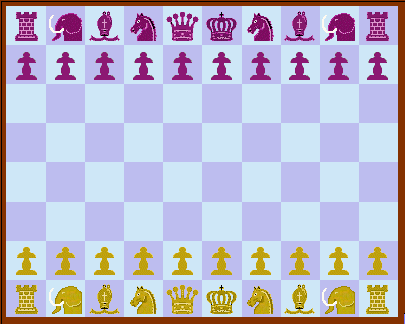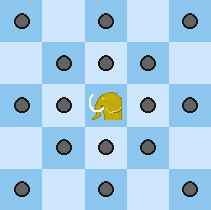

The objective in Mastodon Chess (8x10) is checkmate. The name not only reflects on the Mastodon piece (also called Mammoth), but also on the size of the board, which is 8x10. Pieces move as in orthodox chess, with the exception of the additional piece, the Mastodon. It jumps two steps diagonally or orthogonally, or steps one square in all directions. It has roughly the same value as Rook + Pawn. The Mastodon jump complements the jump move of the Knight. A Mastodon, together with a King, can give mate to a lonely King. The pawns move as in orthodox chess, inclusive of the initial double-step and 'en passant'. Castling exists, but the King jumps three squares instead of two. As usual, the Rook ends up beside the King. Promotion rules are the same as in orthodox chess (with the addition of the Mastodon).
 The Mastodon jumps one
or two steps diagonally
or orthogonally.
The Mastodon jumps one
or two steps diagonally
or orthogonally.
The Mastodon is a piece which is easily mastered, very suited for the congested environment in a game with many pieces and pawns. Although it is somewhat slow, as soon as it becomes active it is very powerful. It is sometimes better than the Queen in attacks on the enemy King. The Mastodon equals Rook + Pawn on a standard 8x8 board, but on this board it is roughly equal to a rook. King + Mastodon wins against King + Bishop or Knight, and draws against King + Queen. The Knights are placed beside the royal pieces in the initial position. Otherwise the Knights' development squares would coincide with the Mastodons' development squares, and the enemy Bishops would control important development squares of the Mastodons. This opening setup has been found to work very well. In an alternative variant, Kwaggas take the place of the knights. In another variant the knights are replaced by Donkeys (see the downloadable zip-file).
Mastodon Chess (8x10) is related to Mastodon Chess (10x10), which uses the same pieces. The Mastodon piece (also called Mammoth) is not new. In E. V. Greenwood's Renniassance Chess (not misspelt) from 1980, the piece is named Squire. The earliest reference I know is Paulovits's Game, c.1890, where it is called Pasha (cf. The Classified Encyclopedia of Chess Variants). Chess variants featuring big boards have been invented before, most notably Tamerlane Chess, allegedly invented by Timur Lenk, C. Freeling's Grand Chess, and Capablanca's chess, invented by the former world champion.
• You can download my free Mastodon Chess (8x10) program here (updated 2009-04-27), but you must own the software Zillions of Games to be able to run it.
• Try playing Mastodon Chess (8x10) by e-mail, against a human opponent, here.
• Don't miss my other chess variants.
© M. Winther 2006